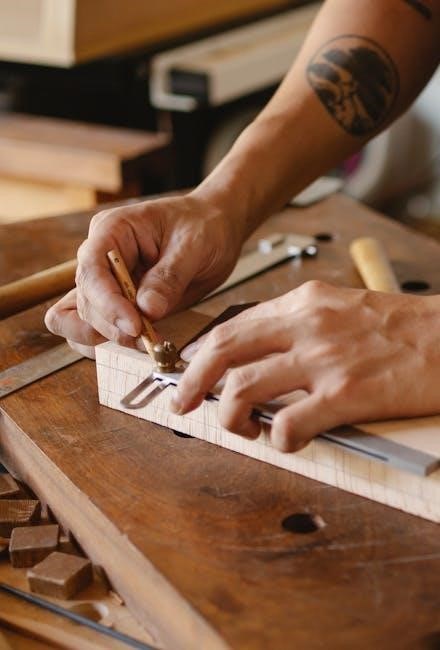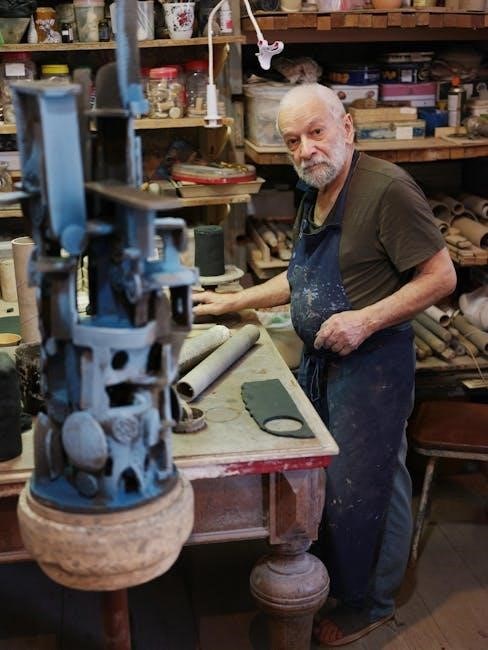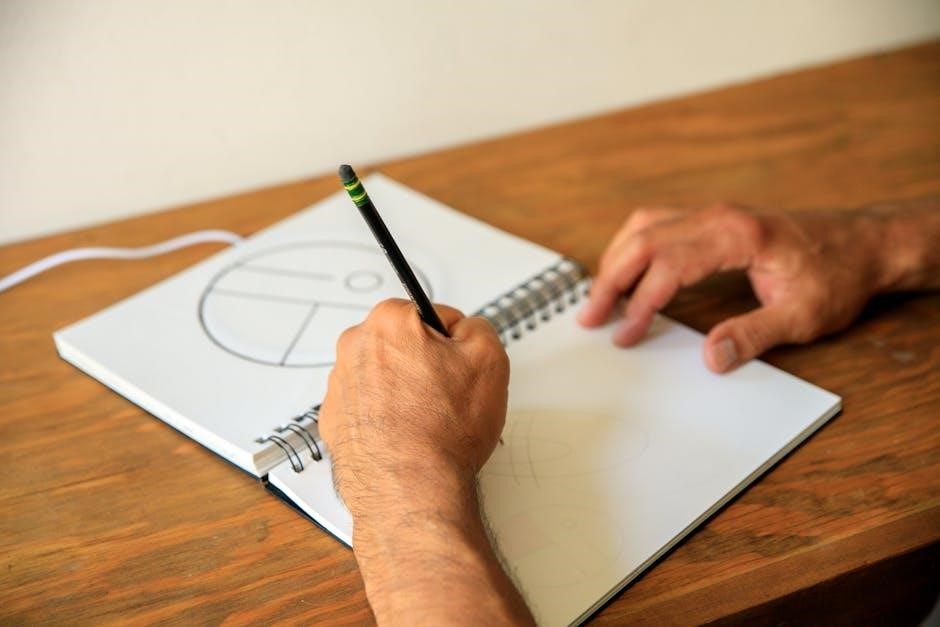The discussion of “manual vs. male” explores societal perceptions of manual labor and gender roles‚ examining how these concepts shape industries‚ traditions‚ and modern workplace dynamics.
Defining Manual and Male in Context
Manual labor refers to work requiring physical effort and hands-on skills‚ often in industries like manufacturing or construction. The term “male” in this context relates to traditional gender roles‚ where certain professions have historically been dominated by men. Societal norms and expectations have shaped these distinctions‚ influencing perceptions of work and gender. Understanding these definitions is crucial for exploring how manual labor and male-dominated fields intersect and impact modern workplaces and cultural dynamics. This framework sets the stage for analyzing their historical‚ psychological‚ and economic implications.
The Purpose of the Article
This article aims to explore the intersection of manual labor and gender roles‚ focusing on societal perceptions and historical contexts. By examining traditional gender roles and modern shifts‚ it seeks to understand how these concepts shape industries and workplace dynamics. The purpose is to provide insight into the challenges and opportunities associated with manual labor and male-dominated fields‚ while fostering a dialogue on inclusivity and equality. Through this exploration‚ the article hopes to shed light on the evolving nature of work and gender‚ offering a comprehensive understanding of their interplay in contemporary society.
Understanding Manual Processes
Manual processes refer to tasks requiring human intervention‚ often involving physical labor or hands-on skills. These processes are essential in industries where automation isn’t feasible‚ ensuring precision and adaptability.
What Constitutes a Manual Task?
A manual task involves physical or hands-on activities requiring human effort‚ often in industries like manufacturing‚ construction‚ or craftsmanship. It demands precision‚ skill‚ and adaptability‚ distinguishing it from automated processes. These tasks are essential in sectors where machinery cannot fully replicate human dexterity or judgment. Examples include assembly line work‚ carpentry‚ and mechanical repairs. Manual tasks often require strength‚ coordination‚ and attention to detail‚ making them integral to producing high-quality‚ customized‚ or complex products. They also play a crucial role in maintaining infrastructure and ensuring safety in various professional settings‚ relying heavily on human expertise and experience.
The Role of Manual Labor in Various Industries
Manual labor is a cornerstone of industries like construction‚ manufacturing‚ and agriculture‚ where physical effort and dexterity are essential. Construction relies on workers for building‚ lifting‚ and operating machinery‚ ensuring infrastructure development. Manufacturing depends on assembly line workers and machine operators to produce goods‚ while agriculture requires laborers for planting‚ harvesting‚ and livestock care. Even in service industries‚ roles like hospitality and healthcare involve manual tasks. These industries thrive on human skills‚ adaptability‚ and strength‚ making manual labor indispensable despite technological advancements. Its contribution to economic productivity and societal well-being remains irreplaceable in many sectors.

Exploring Male-Dominated Fields
Male-dominated fields are industries where men historically outnumber women‚ often due to physical demands‚ societal stereotypes‚ or traditional role expectations‚ shaping workforce dynamics.
Historical Context of Male Dominance in Certain Professions
Male dominance in certain professions stems from historical societal norms‚ where roles were often divided based on gender. Industries like manufacturing and construction were traditionally seen as male-oriented due to physical demands and cultural expectations. Over time‚ this led to a lack of female representation in these fields. Gender roles were reinforced through generations‚ with men often encouraged toward manual labor while women were directed toward caregiving roles. This historical divide has slowly begun to shift‚ but remnants of these traditions still influence modern workforce dynamics.
Current Trends in Male-Dominated Industries
Male-dominated industries are experiencing shifts due to evolving societal norms and technological advancements. There is a growing emphasis on diversity and inclusion‚ with more women entering traditionally male-dominated fields. Automation and AI are transforming manual labor‚ requiring new skill sets. Industries like tech and manufacturing are seeing increased female participation‚ challenging historical gender norms. Additionally‚ there is a focus on creating inclusive workplaces to attract a diverse talent pool. These changes reflect broader societal efforts to promote gender equality and adapt to modern workforce demands.

Gender Roles and Their Impact
Traditional gender roles often associate manual labor with masculinity‚ influencing career choices and workplace dynamics. Modern shifts challenge these norms‚ fostering inclusivity and redefining societal expectations.
Traditional Gender Roles in Manual Labor
Traditional gender roles have historically associated manual labor with masculinity‚ often relegating women to less physically demanding tasks. These roles‚ shaped by cultural and societal norms‚ have been passed down through generations. Men were typically expected to engage in manual work‚ seen as a symbol of strength and provider status‚ while women were often confined to domestic roles. This division of labor has influenced job distributions‚ with male-dominated industries like construction and manufacturing reflecting these stereotypes. Such perceptions‚ though slowly evolving‚ continue to impact workforce dynamics and societal expectations surrounding gender and work.
Modern Shifts in Gender Roles
In recent decades‚ traditional gender roles in manual labor have begun to shift‚ with women increasingly entering male-dominated fields like construction and engineering. Societal attitudes are evolving‚ and policies promoting gender equality are breaking down barriers. Technology and automation are also reducing physical demands‚ making manual labor more accessible to diverse workers. Education and training programs are encouraging women to pursue careers historically seen as male-oriented. These changes reflect a broader movement toward gender equality‚ challenging stereotypes and creating opportunities for a more inclusive workforce across industries.

Psychological Aspects of Manual vs. Male
Societal norms are evolving‚ enabling more women to enter traditionally male-dominated manual labor roles‚ supported by inclusive policies and technological advancements that foster equality and diversity.
Perception of Manual Work Among Men
Manual work is often perceived by men as a reflection of strength‚ resilience‚ and capability‚ deeply rooted in traditional gender roles. Many men view manual labor as a source of pride and identity‚ associating it with masculinity. Societal expectations often reinforce this perception‚ emphasizing physical prowess and problem-solving skills. However‚ this mindset can sometimes limit emotional expression‚ as men in manual roles may feel pressured to prioritize endurance over vulnerability. This perception influences mental health‚ as the stigma of showing weakness can deter men from seeking support. The interplay of societal norms and personal fulfillment shapes attitudes toward manual work.
The Influence of Gender Stereotypes on Career Choices
Gender stereotypes significantly shape career decisions‚ often steering men toward manual or male-dominated fields. Societal norms associate masculinity with technical skills and physical labor‚ discouraging men from pursuing roles traditionally seen as feminine. This limits career diversity and reinforces occupational segregation. Women‚ conversely‚ are often encouraged toward caregiving or administrative roles. Such stereotypes restrict personal and professional growth‚ as individuals may feel pressured to conform rather than explore diverse opportunities. Challenging these norms is essential for fostering inclusivity and allowing individuals to pursue careers that align with their passions and abilities‚ rather than societal expectations.

Communication Styles: Manual vs. Male
Manual professions often require clear‚ direct communication for task efficiency‚ while male-dominated fields may emphasize assertive‚ competitive interactions‚ reflecting different cultural and workplace expectations.
Communication in Manual-Oriented Professions
Communication in manual-oriented professions often emphasizes practicality and clarity. These roles typically require direct‚ task-focused interactions to ensure efficiency and safety. Workers rely on clear instructions‚ visual cues‚ and precise terminology to convey complex tasks effectively. Non-verbal communication‚ such as hand signals or gestures‚ is also common in environments where verbal exchanges may be limited. Teamwork is often central‚ fostering a collaborative atmosphere where clear communication is essential for coordinating efforts. The focus is on achieving shared goals‚ making brevity and precision key elements of interaction in these professions. This style contrasts with more formal or hierarchical communication found elsewhere.
Communication Styles in Male-Dominated Workplaces
Communication in male-dominated workplaces often reflects assertive and competitive interaction styles. These environments tend to prioritize problem-solving and action-oriented discussions‚ with a focus on directness and clarity. Hierarchical structures may influence how information is shared‚ with decision-making often centralized. While this can foster efficiency‚ it may also lead to a perception of exclusivity or intimidation. However‚ there is a growing emphasis on adapting these styles to promote inclusivity and collaboration‚ ensuring diverse perspectives are valued. This shift reflects broader societal changes toward more equitable communication practices in traditionally male-dominated fields.

Technology’s Role in Manual vs. Male
Technology significantly impacts manual labor by enhancing efficiency and reducing physical strain‚ while male-dominated industries leverage tech for innovation and role evolution. Automation reshapes both sectors.
Automation and the Future of Manual Labor
Automation is revolutionizing manual labor by replacing repetitive tasks with machines‚ enhancing efficiency‚ and reducing workplace injuries. While this shift increases productivity‚ it also raises concerns about job displacement. Workers in manual-intensive industries must adapt by acquiring new skills‚ such as operating and maintaining automated systems. This transition underscores the need for retraining programs to ensure employability. As automation advances‚ manual labor roles are evolving‚ requiring a blend of technical expertise and human oversight. The future of manual labor lies in striking a balance between human effort and technological innovation to remain competitive and sustainable.
Technology in Male-Dominated Industries
Male-dominated industries‚ such as construction‚ manufacturing‚ and tech‚ are increasingly adopting advanced technologies like AI‚ IoT‚ and robotics. These tools enhance efficiency‚ streamline processes‚ and improve safety standards. However‚ the integration of technology also highlights the gender gap‚ as women remain underrepresented in these sectors. To foster inclusivity‚ companies are encouraging diversity initiatives and upskilling programs. Technology not only modernizes workflows but also creates opportunities for breaking gender stereotypes‚ promoting a more balanced and innovative workforce. The blend of technology and diverse perspectives can drive long-term growth and sustainability in traditionally male-dominated fields.
Education and Training
Education and training programs are tailored to develop manual skills and expertise in male-dominated fields‚ emphasizing practical learning and hands-on experience to prepare individuals for industry demands.
Training Programs for Manual Skills
Training programs for manual skills focus on developing proficiency in hands-on tasks‚ such as tool operation‚ craftsmanship‚ and physical dexterity. These programs often include workshops‚ simulations‚ and hands-on exercises to enhance technical abilities. Emphasis is placed on safety protocols‚ problem-solving‚ and efficiency. Many industries‚ like manufacturing and construction‚ rely on these programs to ensure workers can perform physically demanding roles effectively. Such training bridges skill gaps and prepares individuals for real-world challenges‚ fostering expertise in manual labor. These initiatives are crucial for maintaining high standards in industries dependent on manual skills.
Education in Male-Dominated Fields
Education in male-dominated fields often emphasizes technical skills‚ STEM disciplines‚ and leadership development. These programs are designed to prepare individuals for industries like engineering‚ technology‚ and construction‚ where men historically predominate. Courses frequently include hands-on training‚ problem-solving exercises‚ and collaborative projects. Despite efforts to promote gender diversity‚ these fields remain male-centric‚ with tailored initiatives to attract underrepresented groups. Such educational pathways aim to foster innovation and adaptability‚ ensuring graduates are equipped to thrive in competitive‚ male-dominated environments while addressing the gender gap in these sectors.

Social Perceptions and Stigmas
Social perceptions often stigmatize manual labor as less prestigious‚ while male-dominated fields are frequently viewed as exclusive‚ reinforcing gender stereotypes and limiting diversity in these sectors.
Social Views on Manual Labor
Society often views manual labor as less prestigious than white-collar jobs‚ perpetuating stigmas that associate it with lower skill levels or educational attainment. Many perceive manual work as physically demanding but intellectually undemanding‚ leading to a lack of respect for those in these roles. Additionally‚ there is a cultural bias that equates manual labor with traditional masculinity‚ reinforcing gender stereotypes. However‚ modern perspectives are shifting‚ recognizing the value and skill required in manual professions. Despite this‚ historical stigmas persist‚ impacting the self-esteem and social standing of workers in these fields.
Stigmas Associated with Male-Dominated Professions
Male-dominated professions often carry stigmas that discourage diversity and inclusion. Many view these fields as unwelcoming to women‚ perpetuating gender stereotypes. Additionally‚ there is a perception that men in these roles must conform to traditional masculine traits‚ such as emotional suppression‚ which can hinder mental health discussions. These stigmas also deter men from pursuing non-traditional careers‚ fearing judgment. Society’s rigid expectations of masculinity further entrench these biases‚ limiting career choices and fostering inequality. Addressing these stigmas is crucial for creating a more inclusive and equitable workplace culture.

Economic Implications
Manual labor significantly impacts operational costs and productivity‚ while male-dominated industries often drive market trends and economic stability. Balancing these factors is crucial for sustainable growth.
Economic Impact of Manual Labor
Manual labor plays a significant role in shaping economic landscapes‚ influencing operational costs and productivity across industries. It often represents a substantial expense for businesses‚ particularly in sectors like manufacturing and construction. However‚ manual labor also drives local economies by creating jobs and stimulating demand for tools and equipment. Industries reliant on manual labor face challenges such as wage fluctuations and workplace injuries‚ which can strain budgets. Despite these challenges‚ manual labor remains a critical component of economic activity‚ ensuring the production and delivery of essential goods and services.
Economic Influences on Male-Dominated Industries
Male-dominated industries‚ such as construction and manufacturing‚ are heavily influenced by economic factors that shape their growth and stability. Investment trends‚ government policies‚ and market demand often favor these sectors‚ creating a cycle of economic reliance. Higher wage structures and unionization in these fields attract male workers‚ perpetuating their dominance. Economic downturns‚ however‚ can disproportionately affect these industries‚ leading to job losses and instability. Additionally‚ technological advancements and automation are reshaping these sectors‚ creating both opportunities and challenges for sustained economic relevance and gender diversity in the workforce.

Health and Safety
Manual labor often involves physical risks‚ while male-dominated industries face unique safety challenges. Ensuring health and safety requires strict protocols and addressing both physical and mental well-being.
Health Risks in Manual Labor
Manual labor often involves physical strain‚ leading to musculoskeletal injuries‚ repetitive strain disorders‚ and workplace accidents. Prolonged exposure to hazardous materials can cause respiratory and skin conditions. Mental health risks‚ such as stress and fatigue‚ also arise from demanding work environments. These risks are exacerbated by inadequate safety training and insufficient protective equipment. Long-term health issues‚ including chronic pain and occupational diseases‚ are common among manual workers. Addressing these risks requires robust safety protocols‚ regular health screenings‚ and ergonomic workplace designs to mitigate the physical and mental toll of manual labor.
Safety Measures in Male-Dominated Workplaces
In male-dominated workplaces‚ safety measures are critical to reducing workplace injuries and fatalities. Employers often implement strict protocols‚ including mandatory PPE‚ regular safety training‚ and emergency drills. Hazard identification and risk assessment processes are prioritized to mitigate dangers. Leadership plays a key role in fostering a safety-first culture‚ encouraging open reporting of incidents without retaliation. Mental health support is increasingly integrated to address stress and fatigue. These measures aim to create a safer environment‚ ensuring compliance with regulations and promoting overall well-being in traditionally high-risk industries.
Work-Life Balance
Work-life balance is crucial for well-being‚ especially in manual and male-dominated fields. It involves managing time effectively to maintain personal and professional life without causing burnout or stress.
Work-Life Balance in Manual Professions
Work-life balance in manual professions is often challenging due to physical demands and long hours. Employees in these roles frequently struggle to disconnect from work-related stress‚ leading to burnout. Many manual workers face irregular schedules‚ overtime‚ and limited flexibility‚ making it difficult to maintain personal time. However‚ some employers are implementing policies like flexible shifts and wellness programs to support better work-life balance. Encouraging time management and mental health resources can help manual workers recharge and sustain their productivity over time.
Work-Life Balance in Male-Dominated Careers
In male-dominated careers‚ achieving work-life balance is often hindered by demanding schedules and high-pressure environments. Long hours and stress can encroach on personal time‚ impacting mental and physical health. Many men in these fields face societal expectations to prioritize career over family‚ exacerbating the challenge. However‚ progressive companies are increasingly offering flexible schedules and paternity leave to support balance. Encouraging open conversations about work-life balance and reducing stigma around prioritizing personal time can foster healthier lifestyles and more fulfilling careers for men in these industries.

Future Trends
The future of manual labor lies in automation and AI‚ reducing physical demands. Male-dominated fields are adapting‚ emphasizing technical skills and innovation to stay relevant and competitive globally.
Future of Manual Labor
Manual labor is expected to evolve significantly with advancements in automation and AI. While repetitive tasks may be replaced by machines‚ there will be a growing demand for skilled workers who can operate and maintain advanced technologies. Safety standards will likely improve as robotics handle hazardous tasks‚ reducing workplace injuries. Additionally‚ the integration of wearable technology could enhance worker efficiency and reduce physical strain. However‚ this shift may require extensive retraining programs to prepare the workforce for new roles‚ ensuring that manual labor remains relevant in an increasingly tech-driven world.
Emerging Trends in Male-Dominated Fields
Male-dominated industries are witnessing a shift toward diversity and inclusion‚ with increasing efforts to attract underrepresented groups. Technology is reshaping these fields‚ emphasizing innovation and digital literacy. Leadership styles are evolving‚ with a focus on collaboration and emotional intelligence. Additionally‚ there is a growing emphasis on sustainability and environmental responsibility‚ influencing industry practices. These trends reflect broader societal changes‚ challenging traditional norms and fostering a more inclusive and adaptive workforce. As industries modernize‚ they must address barriers to entry for diverse talent to remain competitive in a changing global economy.
The conclusion highlights the evolution of manual labor and male-dominated fields‚ emphasizing how traditional roles are being challenged. The push for inclusivity and adaptability is crucial.
This article explored the interplay between manual labor and male-dominated industries‚ discussing historical contexts‚ gender roles‚ and psychological perceptions. It highlighted how societal norms influence career choices and communication styles‚ emphasizing the impact of technology and education. Economic implications‚ health risks‚ and work-life balance were also addressed‚ alongside future trends like automation and shifting gender dynamics. The key takeaway is the need for adaptability and inclusivity in evolving work environments.
Final Thoughts on Manual vs. Male
The discussion of manual labor and male-dominated fields highlights evolving societal norms and workplace dynamics. While manual work remains essential‚ technological advancements are reshaping its future. Gender roles are gradually shifting‚ offering more inclusivity in traditionally male-dominated professions. Addressing stereotypes‚ improving safety‚ and fostering work-life balance are critical for progress. Embracing change and promoting diversity will ensure sustainable growth in both manual and male-dominated industries‚ creating equitable opportunities for all.

